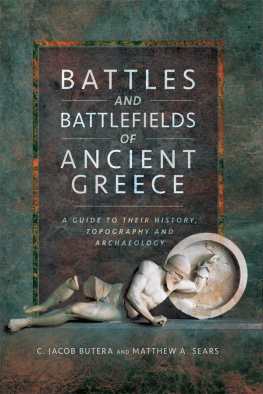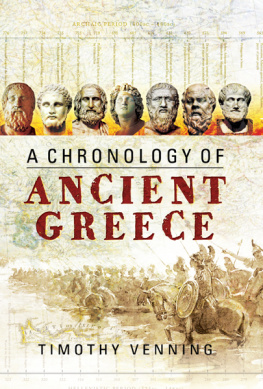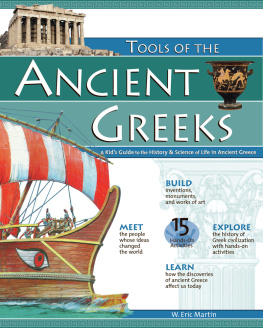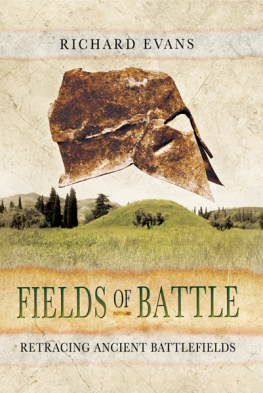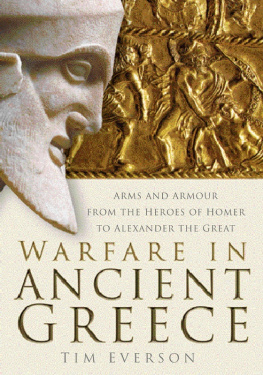Pagebreaks of the print version

Battles and Battlefields of Ancient Greece
Battles and Battlefields of Ancient Greece
A Guide to their History, Topography and Archaeology
C. Jacob Butera and Matthew A. Sears
First published in Great Britain in 2019 by
Pen & Sword Military
An imprint of
Pen & Sword Books Ltd
Yorkshire Philadelphia
Copyright C Jacob Butera and Matthew A Sears 2019
ISBN 978 1 78383 186 9
eISBN 978 1 47388 999 6
Mobi ISBN 978 1 47388 998 9
The right of C Jacob Butera and Matthew A Sears identified as Authors of this work has been asserted by them in accordance with the Copyright, Designs and Patents Act 1988.
A CIP catalogue record for this book is available from the British Library.
All rights reserved. No part of this book may be reproduced or transmitted in any form or by any means, electronic or mechanical including photocopying, recording or by any information storage and retrieval system, without permission from the Publisher in writing.
Pen & Sword Books Limited incorporates the imprints of Atlas, Archaeology, Aviation, Discovery, Family History, Fiction, History, Maritime, Military, Military Classics, Politics, Select, Transport, True Crime, Air World, Frontline Publishing, Leo Cooper, Remember When, Seaforth Publishing, The Praetorian Press, Wharncliffe Local History, Wharncliffe Transport, Wharncliffe True Crime and White Owl.
For a complete list of Pen & Sword titles please contact
PEN & SWORD BOOKS LIMITED
47 Church Street, Barnsley, South Yorkshire, S70 2AS, England
E-mail:
Website: www.pen-and-sword.co.uk
Or
PEN AND SWORD BOOKS
1950 Lawrence Rd, Havertown, PA 19083, USA
E-mail:
Website: www.penandswordbooks.com
Preface and Acknowledgements
T his is a book designed for the traveller to Greece, whether the member of a tour group, the independent adventurer, or the curious scholar. We think that the material covered here is both interesting enough to appeal to the general reader, and detailed enough to be of use to more seasoned students of ancient history. Most importantly, we believe that the fullest appreciation of ancient history, especially as relates to battles and battlefields, is only gained by visiting the places themselves, by pondering the beautiful and haunting landscapes of Greece, and by imagining where great armies clashed so long ago. Our lives were certainly changed by our first visits to Greece, and they continue to be changed every time we go back.
This book is divided into chapters covering individual battlefields, each of which was the scene of one or more important clashes in antiquity. These sites are divided first by region, and then chronologically within each region. Each chapter begins with a brief note on the importance and interest of the battle covered, followed by a description of how the modern traveller can find the site. The largest part of each chapter consists of the historical overview of the battle, in which we provide a narrative account based on a critical study of the ancient literary, topographical, and archaeological sources, along with the most important work of modern scholars. There follows a description of the battle site as it is today, along with suggestions for how best to view and interpret different parts of the site and different phases of the battle. Major landmarks are given GPS coordinates to facilitate navigation. The end of each chapter consists of suggestions for further reading, including annotated lists of ancient sources as well as modern books and articles.
To get the most out of this book, we suggest that the traveller purchase a good roadmap of Greece (1:400,000 scale should be enough), available for purchase at many tourist shops but especially at the Athens International Airport and at various car-rental agencies. A dashboard GPS unit or, even better, a handheld device would be a great asset in the field, and there are many detailed GPS maps of Greece available as free downloads. Since many of the sites covered in this book are off the beaten path (the ancients didnt always fight their battles within sight of major tourist attractions), we suggest readers take the plunge and rent a car to explore the country themselves and at their own pace. Though it might seem intimidating at first, driving in Greece need not be overly harrowing, especially outside of Athens. The most popular Greek destinations, from the Athenian Acropolis to the sanctuary of Delphi, are indeed spectacular. But the less-visited parts of Greece offer many benefits, including unbeatable seaside hotels and delicious (and cheap!) food and drink. Greece is a country that handsomely rewards exploration.
We owe a debt of gratitude to many friends, colleagues, and institutions for material and moral support in preparing this book. First and foremost, the American School of Classical Studies at Athens, a top-rate scholarly institution and wonderful home in Greece, looms large over this project. The authors first met each other and discussed the possibility of this book while students at the school, and we thank especially John Oakley, Jack Davis, and Kirk Ormand for teaching us so much during our time as students. All continue to be supportive colleagues as we have transitioned into university faculty members ourselves. For his part, Kirk has accompanied us to more battlefields than anyone should rightly be expected to. The American School offered us financial support to live in Greece for extended periods, and always has a ready supply of eager students and faculty for us to share ideas with when we are in the country. The University of New Brunswick, the University of North Carolina at Asheville, Brigham Young University, the National Endowment for the Humanities, and the Harrison McCain Foundation have also provided invaluable financial assistance over the course of this project.
Jenny Denault, Matthew Searss wife and travelling companion, was with us at the American School, and has visited site after site with us since. Though we frequently tested her patience with our enthusiasm for dusty plains, she always kept us grounded and reminded us that beaches and seaside tavernas are a vital part of visiting Greece too. Many have commented on specific chapters or offered their valuable insights along the way. We would like to thank in particular Lee Brice, Glenn Bugh, Denver Graninger, John Hale, Peter Krentz, Maria Liston, James Murray, Keven Ouellet, Jacques Perreault, Emmanuel Stefanakis, Jake Stoddard, Barry Strauss, and Georgia Tsouvala. Without the support of Phil Sidnell, our editor at Pen & Sword, this book would not have happened. Last but not least, we would like to thank our students, whose keen interest in ancient history always keeps us honest and on our toes.
Introduction
Ancient Greek and Roman Warfare
T his book covers nearly five centuries of ancient warfare in what is now modern Greece, from Marathon in 490 BCE to Actium in 31 BCE. Over this long period, Greece saw a wide range of battles on land and sea, including clashes of Greeks against Greeks, Greeks against Macedoniaians, Macedoniaians against Romans, and Romans against Romans. The whole gamut of ancient tactics and strategy is represented by these battles, from heavy-armed phalanxes to mobile cavalry and archers, and from armies struggling on broad plains to navies fighting in narrow straits. Ancient warfare is an immense topic of study, covering subjects including the role of warfare in ancient politics, society and culture; and the legacy of ancient warfare for the modern world. This introduction provides a brief overview of ancient battlefield tactics, primarily those that played a major role in the specific battles covered in the book. Some suggestions for further reading finish the chapter, for those wishing to delve more deeply into the broader phenomenon of warfare in the ancient world.

